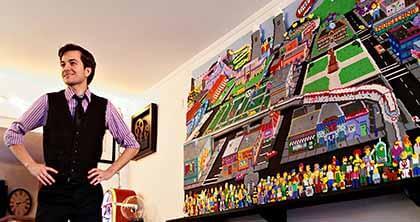By Joe Anuta
One line in a Broadway-style song from the legendary cartoon “The Simpsons” goes like this: “Springfield, Springfield, it’s a hell of a town. The school yard’s up and the shopping mall’s down.”
Those lyrics provide a small hint of the town’s layout, but Forest Hills artist Kyle McCoy had to design Springfield from scratch when he spent two years painstakingly constructing a model of the fictional city.
“I questioned the time and effort put into this project,” he said to a small crowd of well-dressed friends from atop a chair in his living room, where he unveiled the 40-square-foot artwork stuck to his wall at a party Friday. “There were so many other things I could have been doing … but now I know it was worth it.”
And with a drop of the red curtain, McCoy had party-goers in their 20s and 30s — who grew up watching the iconic sitcom — soaking in booze and nostalgia at the sight of “Project Springfield.”
“‘The Simpsons’ had such an impact on us as children,” said Peter Gerena, a friend of McCoy’s. “It was intelligent and funny in a way that is still relevant.”
The cartoon, which began in 1989, was the first animated series geared toward adults, which allowed for sometimes absurd yet consistently hilarious tales of life in America that were not possible before.
“It’s an animated series, and yet the characters are drinking beer and there are corrupt politicians, priests who don’t care about their flock and all the cops take bribes,” McCoy said, referring to various characters in the show.
The sitcom was so influential it spawned legions of fans.
It is rare to find someone with an encyclopaedic knowledge of a show like “Popeye,” but many party-goers could discuss specific episodes of “The Simpsons” in such detail a casual observer might think they wrote dissertations on the subject — one friend of McCoy’s even posed the idea of cross-checking the layout of the model with Simpsons video games that take place in Springfield.
That same influence also drove McCoy — who has a Simpsons pinball machine and arcade game in his living room as well — to spend two years carefully planning and constructing the model out of individual colored beads about the size of corn kernels.
“There is actually no set layout to the town,” McCoy said. “It changes from episode to episode, so I had to make my own design.”
McCoy used roughly 140,000 of the beads to construct buildings from the show — like the Simpsons’ home, the town church and a derelict Monorail — in a pixilated style reminiscent of video games in the late 1980s and ’90s, which also impressed the audience.
“If this was done in paint, it wouldn’t be as impressive,” Gerena said.
Pixels are the tiny building blocks of color in every video game and computer screen, but they have dramatically shrunk in size over the last 30 years.
That is why the pixilated model instantly recalls the first era of video games, which happened to coincide with “The Simpsons.”
Blocky figures barely recognizable as human took children on adventures into strange lands in games like “Super Mario Bros.’” and “The Legend of Zelda” for the first time. “The Simpsons” was even made into several games.
Pixel art is one of McCoy’s specialities — many smaller artworks adorn the walls of his house — and any subject matter he tackles, especially “The Simpsons,” has a tendency to send viewers back in time.
“I feel like every kid should play ‘Super Mario Bros.,’” said Darren Levy, another of McCoy’s friends. “I have an appreciation for art before my time. They should have an appreciation for pixel art.”
McCoy lives with his wife Becky Ferreira in Forest Hills, and teaching music and theater to elementary students at Rhinelander Children’s Center in Manhattan.
Reach reporter Joe Anuta by e-mail at januta@cnglocal.com or by phone at 718-260-4566.


































